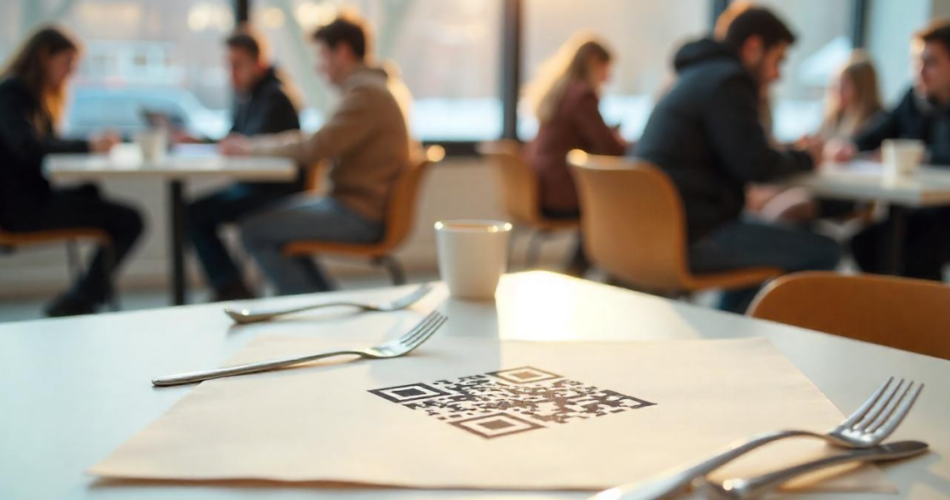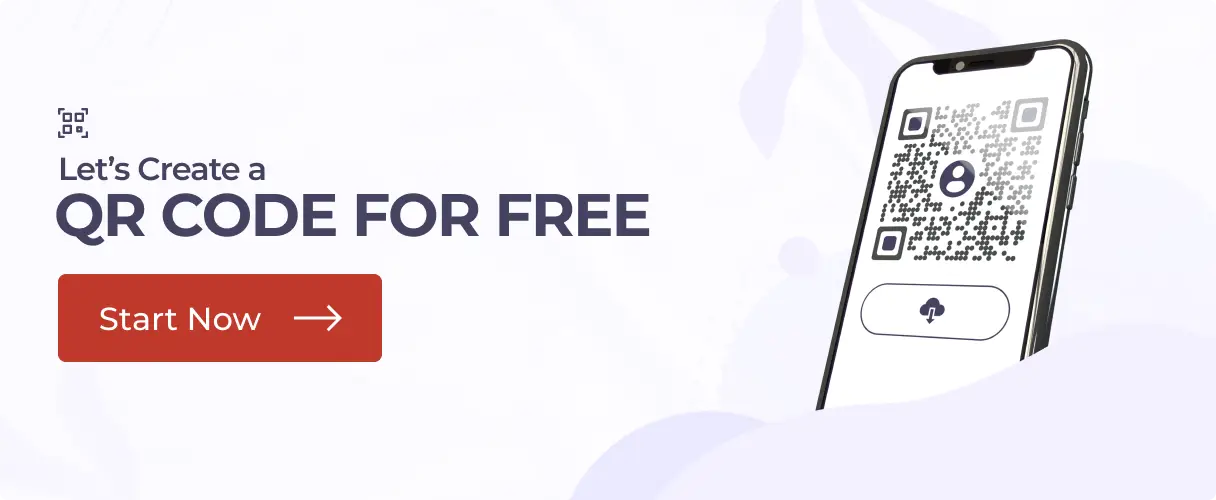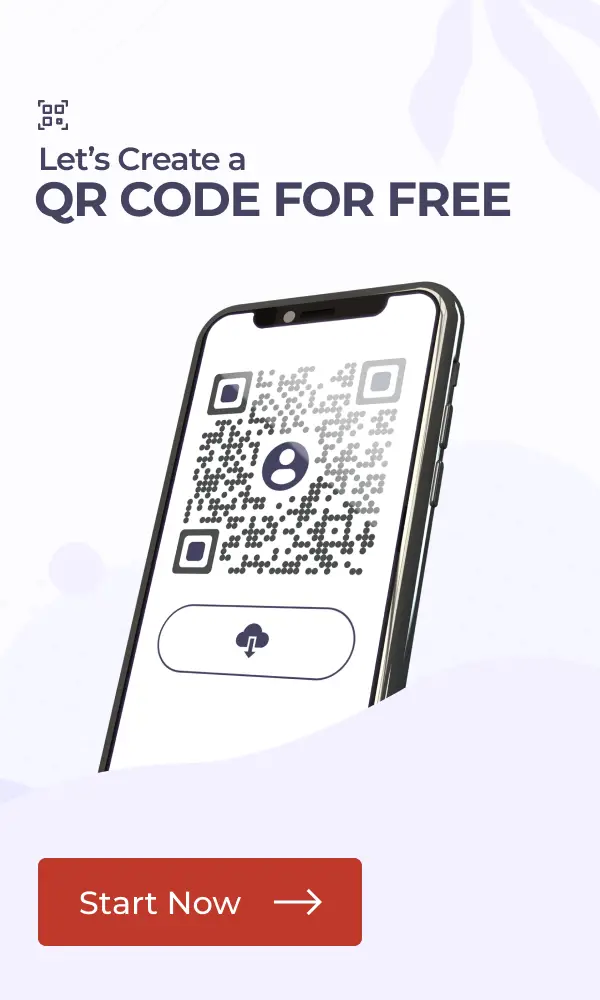TLDR: Table QR Codes are making restaurants faster, smarter, and more efficient. Guests can scan to view menus, order, pay, or leave feedback; no app is needed.
They cut wait times, reduce errors, and improve hygiene. For businesses, they lower costs, enable real-time updates, and offer valuable data.
Whether on table tents or napkin holders, they boost service without extra staff. Big brands like Burger King and Starbucks are already using them. The future of dining is just one scan away.
Forget paper menus and long payment queues.
QR Codes on tables are changing how restaurants serve customers.
They’re fast, hygienic, and smart.
In this blog, you will learn how putting a QR Code on table, counters, and tents can improve your restaurant’s service.
So, let’s kick off!
A. What is a table QR Code?
A table QR Code is a tiny scannable code put on a restaurant table that consumers can scan with their mobile phone to view a digital menu, order, or pay.
It eliminates printed menus, speeds up wait times, and provides a cleaner, sleeker experience.
These codes work with any smartphone camera—no app is needed.
Some are static (fixed links), while dynamic QR Codes let you update content without reprinting.
Even when staff is busy, the code keeps working—giving customers control and making service faster and smoother.
A Deloitte study found that 40% of customers want to hear from a restaurant once a month or more. They prefer that 80% of these interactions be about discounts and special offers. Source: Deloitte
B. Why are table QR Codes more than just a trend?
1. They fix the chaos during rush hours
Imagine this: it’s 1 PM, the lunch rush is pouring in, and your servers are struggling to keep up.
Servers are running between several tables, guests are getting impatient, and the queue at the counter is lengthening by the minute.
Now, imagine each table has a QR Code. A guest walks in, sits down, scans the code, and within seconds—they’ve got the menu, placed an order, and paid.
No delays. No waiting. That tiny square streamlined the process and gave your staff some breathing room.
2. They remove friction from the customer journey
We’ve all been there—trying to get a server’s attention just to ask for the check or see a menu. It’s awkward, inefficient, and, let’s face it, a little annoying.
Table QR Codes cut out all that friction. One scan and guests have everything they need on their phones.
From viewing the full menu, customizing their orders, to checking out with mobile payment—it all happens in a few taps.
It turns a clunky process into a smooth, self-service experience.
3. They make menus smarter—and more efficient
Unlike physical menus that need reprinting or crossing out items with a pen, digital menus connected to QR Codes update in real-time.
So, if you run out of a dish or add a new seasonal special, it reflects instantly. No more disappointing customers with unavailable items.
No more staff running back to explain, “Sorry, we’re out of that.” Just a clean, current menu—always up-to-date.
4. They personalize the experience for each guest
With the right backend setup, these QR Codes do more than open a menu: they recognize returning customers.
Imagine this: someone scans the code, and the system says, “Welcome back! Want to reorder your last meal?”
Or show them a custom deal based on what they’ve ordered before.
It feels like VIP treatment without needing the staff to remember faces or names.
5. They drastically cut down order errors
When customers order directly through their device, they’re in complete control.
They pick precisely what they want, select toppings, leave notes, and double-check before submitting.
This means fewer mistakes in the kitchen, fewer refunds, and happier guests. It’s a win for both sides: less confusion and more accuracy.
6. They’re being adopted far beyond just restaurants
Table QR Codes aren’t just for food service anymore.
You’ll now spot them in breweries for ordering pints, salons for booking add-ons, and lounges where you can order drinks without leaving your seat.
Even co-working spaces use them to book rooms or order coffee. They’re becoming the go-to tool anywhere people expect quick, contactless service.
7. They give businesses real-time data and insights
Every interaction with a table QR Code is a data point—what’s being ordered, at what time, and how often.
Over time, this data builds a clear picture of customer habits. Business owners can spot trends, identify top-selling items, and test promotions.
It’s like having a built-in analytics dashboard that helps you make better decisions—without expensive tools or guesswork.
C. Key benefits: QR Code table tent
1. Faster service without adding staff
When guests can browse the menu, place their order, and pay—all through a single scan—it shaves minutes off every interaction.
There is no need to wait for menus, flag down a server, or stand in line. That means faster table turnover, more satisfied customers, and no need to hire more staff.
2. Lower operational costs
Say goodbye to printing and reprinting menus every time there’s a price change, seasonal update, or item sold out.
QR Code menus are digital and can be updated instantly without printing costs or design delays. It’s also more eco-friendly—no paper waste, no hassle.
3. Contactless experience customers now expect
Let’s face it: people have gotten used to doing everything on their phones. Scanning a QR Code at the table just feels normal now.
It removes physical touchpoints, reduces contact, and makes guests feel safer and more in control—especially in a post-pandemic world where hygiene matters.
4. Fewer mistakes, happier customers
When guests enter their orders, they get what they want, the last detail. No more “I said no onions!” moments.
The kitchen gets clean clear instructions. That means fewer order remakes, fewer complaints, and a smoother overall experience.
5. Boosts upsells and cross-sells automatically
QR menus can suggest add-ons (“Want to add a drink?”), show popular combos, or highlight deals of the day—all without being pushy.
This kind of smart suggestion boosts average order value without extra effort from staff. It’s like having a built-in digital upsell engine at every table.
6. Real-time updates and flexibility
Running out of a dish? Want to push a new special? No problem. QR Code menus can be updated in seconds.
There is no need to call the printer or wait till next week. You stay agile and critical in food service and other fast-paced industries.
7. Data-driven decisions made easy
With QR Codes, every scan can be tracked.
You’ll know which items are most viewed, which dishes are frequently skipped, and what’s trending on weekends vs weekdays.
This data helps you refine your menu, run smarter promotions, and create a better overall experience.
D. Real-life examples: How restaurants use QR Codes on tables
1. Burger King – Scan to win campaign
Burger King ran a clever in-store campaign where customers found a QR Code printed on table tents.
When scanned, it opened a mobile game that offered instant rewards—like free fries or discounts on their next meal.
It turned a regular dining moment into a fun, branded experience. Smart move: it boosted engagement and app downloads.
2. Starbucks – Seamless ordering without the app
In several international locations, Starbucks placed QR Codes on tables that linked directly to a mobile ordering page. No app needed.
Customers scanned, selected their drinks, and paid—all from their seats. Then, they got a ping when their coffee was ready. It kept queues short and seats full.
3. Buffalo Wild Wings – Self-serve ordering with upsells
This chain introduced table QR Codes to let customers order wings and drinks directly. But here’s the twist—they used smart prompts to suggest add-ons like dips or combo deals.
Every scan became an upsell opportunity, and the average ticket size jumped without servers needing to pitch.
4. Chaayos (India) – Personalized reorders
Chaayos, a popular café chain in India, added QR Codes to tables so customers could reorder their usual tea blend in two taps.
Returning customers scanned the code and saw their previous order right there—no waiting, no confusion.
It made the loyalty experience seamless and kept regulars coming back.
5. Olive Garden – QR Codes for payment and feedback
In select locations, Olive Garden uses table QR Codes for fast checkout. Guests scan to pay their bills, split them with friends, or leave a tip.
But here’s the kicker—they’re also asked to rate their experience. So, the same code helps the brand gather real-time feedback when the experience is fresh.
6. Taco Bell – Interactive menu experience
Some Taco Bell test stores placed QR Codes that opened animated digital menus. Guests could browse ingredients, view allergy info, and even see calorie counts.
It was more than just a menu—it was an interactive tool. It made guests feel informed and in control of their meals.
The staff shortage in the hospitality sector is another issue that QR Codes can help to handle better. The codes can direct customers to a link to order and pay on their phones. Source: theontrade
E. Where can you place table QR Codes?
1. On table tents
This is the classic move. A small triangular table tent sits right in the center of the table, visible from all sides.
It’s great for showcasing a QR Code with a clear call-to-action like “Scan to Order” or “Browse Our Menu.”
Plus, you can change them out easily for seasonal offers or promotions.
2. Printed directly on the tabletop
Want something sleek and permanent? Many restaurants now print QR Codes directly on the table surface.
It saves space and keeps things tamper-proof.
Some places even engrave or embed them into the tabletop design so they blend in while still being functional.
3. On coasters or serving trays
Get creative! Drop your QR Code on drink coasters or even serving trays.
That way, customers interact with it when their food or drink arrives.
It’s perfect for drink refills, dessert menus, or mid-meal feedback prompts.
4. Attached to condiment holders or napkin dispensers
These spots are often before the customer and don’t take up extra space.
A ketchup bottle or napkin holder with a QR Code?
That’s prime real estate for encouraging scans during the meal.
5. On wall-mounted frames above the table
Not every setup works for tabletop placement—especially in tight spaces or outdoor seating.
You can mount the QR Code on the wall above the table in those cases.
Add a bold headline like “Scan Here to Order,” and you have a clean, clutter-free solution.
6. Under a glass table cover
For restaurants that use glass tabletops, you can slide a printed QR Code under the glass.
It’s protected from spills, easy to clean, and always visible.
It also adds a premium, polished look—great for upscale venues.
7. On clipboards or menu boards handed to guests
For places that still hand guests a physical menu or drink list, slap a QR Code right on it.
It lets customers scan for more details—nutritional info, videos, chef notes—or order digitally if preferred.
You’re giving them options without ditching your printed materials.
F. What can you link to a tabletop QR Code?
1. Digital menu with live updates
This is the go-to. Link your QR Code to a mobile-friendly menu that updates in real-time. Out of tiramisu?
Pull it from the list in seconds. Want to highlight your new seasonal cocktail?
Add a banner on the fly. It keeps things fresh and saves your staff from saying, “Sorry, we’re out of that,” for the hundredth time.
2. Self-ordering system
Take it a step further—don’t just show the menu. Let them order right from their phone.
Customers select items, add customizations, and send their orders directly to the kitchen.
No wait, no errors, and no pressure. It’s a smoother, faster experience for everyone.
3. Mobile payment checkout
Give your guests the freedom to pay when they’re ready.
Link the QR Code to a secure payment page where they can split the bill, leave a tip, and get an e-receipt without waving down a server.
It’s quick, easy, and a total game-changer for busy shifts.
4. Loyalty or rewards program
Want customers to come back? Link your QR Code to a loyalty program where diners can sign up, earn points, or redeem offers—right from the table.
It turns a simple scan into a long-term relationship.
Plus, no need for extra apps or punch cards.
5. Customer feedback form
Feedback is gold—but only if you get it while it’s fresh.
Use the QR Code to link to a quick survey asking how their meal went. Keep it short and sweet.
The faster it is, the more responses you’ll get—and the sooner you can fix what’s not working.
6. Promotions and upsell offers
You can also use table QR Codes to serve dynamic content like daily deals, bundle offers, or limited-time items.
Add a countdown timer or a “Most Popular Today” label, and you have a digital upsell tool running 24/7 without lifting a finger.
7. Social media or brand experiences
Want to grow your online presence? Link to your Instagram page, a behind-the-scenes video of your kitchen, or a campaign hashtag.
Some brands even embed AR filters or games.
It’s a fun way to extend the experience beyond the plate—and into your customer’s feed.
G. Common mistakes to avoid: Table QR Code
1. Using poor-quality or blurry QR Codes
Don’t expect results if your QR Code looks like it was printed in 2003 with a dot-matrix printer. Blurry, pixelated, or low-contrast codes won’t scan.
And if it doesn’t scan, customers won’t try twice.
Always test your code before printing, and make sure it’s crystal clear—even from a phone camera across the table.
2. Linking to non-mobile-friendly pages
This one’s a facepalm. Someone scans your code expecting a sleek experience—and lands on a clunky desktop site that’s impossible to navigate on mobile.
Don’t do that.
Your link must be fast, mobile-optimized, and easy to interact with using one thumb.
3. Placing the code in hard-to-reach or awkward spots
You can have the best QR Code in the world, but if it’s hidden behind a flower vase or taped to the side of the table leg, it’s useless.
The code must be in plain view, easy to scan from a seated position, and preferably angled upright so customers don’t need to become contortionists to use it.
4. Not telling people what the QR Code does
QR Codes don’t speak for themselves.
A plain code without context leaves people guessing: “Is this the menu? A payment link? A trap?”
Always pair it with a clear call-to-action—like “Scan to View Menu” or “Pay Your Bill Here.” If you don’t explain it, you’re losing scans.
5. Forgetting to test on different devices
Your iPhone might open the link instantly—but what about that Android user with a five-year-old phone?
Test your QR Code across multiple devices and browsers to ensure it loads fast and works for everyone, not just your team.
6. Linking to static, uneditable content
Printed QR Codes are forever—but your content shouldn’t be.
Don’t make the mistake of linking to a menu PDF that you can’t change.
Use a dynamic QR Code that lets you update the link in the backend without reprinting anything. That’s how you stay flexible and future-proof.
7. Overloading the customer with too many options
Some brands go overboard. One scan leads to a homepage with ten buttons: menu, social media, feedback, events, cat videos, you name it. Keep it focused.
Don’t send them on a digital scavenger hunt if the goal is ordering food. Keep the journey simple and direct.
Brands that trust us:
Final Thoughts
A table QR Code isn’t just a piece of tech—it’s a bridge between great food and experience. It reduces friction, improves operations, and meets your customers where they are—on their phones.
Whether running a food truck or a fine dining spot, adding QR Codes to your tables can upgrade your business.
Ready to digitize your tables? Start with a smart QR Code platform, and transform your guest experience—one scan at a time.


